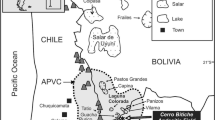Abstract
Pleistocene-Holocene volcanism in the Jalisco block of western Mexico is confined to two conspicuous grabens, where potassic eruptives range from absarokites (48–52% SiO2) and minettes (49–54% SiO2) through basaltic andesites (53–57% SiO2), the most voluminous type, to andesites and their lamprophyric equivalent spessartite (58–62% SiO2); there are no contemporary rhyolitic rocks. This suite has high concentrations of Mg, Cr (<550 ppm) and Ni (<450 ppm) accompanied by large concentrations of K, P, Ba (<4000 ppm) and Sr (<5000 ppm) and elements such as LREE and Zr (<600 ppm). No combination of crystal fractionation and/or crustal contamination can reproduce the compositional range of these magmas, which nevertheless are believed to be genetically related because of their proximity in time and space. Hydrous minerals in the lamprophyres and the typical absence of plagioclase phenocrysts in both basaltic andesites and andesites reflect the relatively high concentrations of water in the magmas, which suppressed the crystallisation of feldspar. Experimental verification of the minimal amounts of water required to reproduce the phenocryst assemblages in selected rocks range from 3.5 to 6%. During ascent in a volcanic conduit, andesitic magma may lose water and consequently precipitate plagioclase, or it may ascend more rapidly, retaining more of its initial water, which stabilises phenocrysts of hornblende at the expense of plagioclase. Our estimates of water concentrations, which are consistent with the various low pressure phenocryst assemblages, will be minimal for the magmas in their source regions, and the process of magmatic dewatering on ascent may be typical in well established volcanic conduits. In accord with the compositions of phenocrystic olivine in the basaltic andesites and the minettes, the values of FeO and Fe2O3 of the bulk lavas and scoriae are demonstrably pristine. As a consequence, there are two characteristic features of the Mascota suite: the high range of relative oxygen fugacities (ΔNNO=1–5) and the high Mg# (MgO/MgO+FeO) that ranges from 0.70 to 0.91 (with only one andesite as low as 0.66). From the evidence of phlogopite phenocrysts, a partial melt involving phlogopite would have a higher Mg# than one from olivine (Fo90) and pyroxene alone. As the Mascota series shows a correlation between K2O and Mg#, we conclude that it was generated by partial fusion of the mantle wedge, with a variable contribution of phlogopite and apatite from veins throughout the lherzolitic assemblage. In conformity with an origin by varying increments of partial fusion of a phlogopite-bearing mantle, all incompatible elements vary linearly with Ti (or K) as if phlogopite (+apatite) in the source dominated their contribution to the partial melts. Fluids from dehydration of the subducting slab presumably deposit hydrous and other minerals in veins in the mantle wedge and also increase its redox state. As the Mascota volcanism occurs in grabens closer to the trench than the main andesite arc, it is concluded that the eruption of these small volumes of hydrous magmas require the tectonically favored ascent paths offered by the extensional grabens to reach the surface from their mantle sources.
Similar content being viewed by others
Author information
Authors and Affiliations
Additional information
Received: 24 January 1995 / Accepted: 21 February 1996
Rights and permissions
About this article
Cite this article
Carmichael, I., Lange, R. & Luhr, J. Quaternary minettes and associated volcanic rocks of Mascota, western Mexico: a consequence of plate extension above a subduction modified mantle wedge. Contrib Mineral Petrol 124, 302–333 (1996). https://doi.org/10.1007/s004100050193
Issue Date:
DOI: https://doi.org/10.1007/s004100050193




